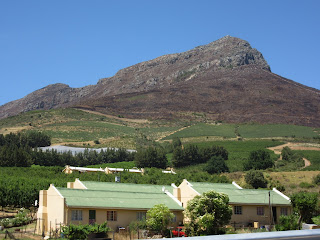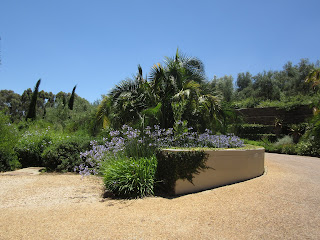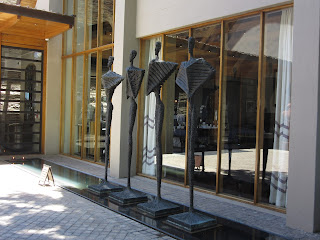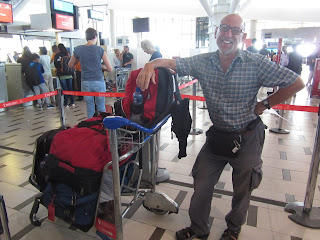No wonder Steven and I each gained a few pounds in Cape Town devouring this mouth-watering spread every morning at the Altona Lodge! The in-house cook prepared a variety of scrumptious made-to-order breakfast daily but, once I tasted his tomato and cheese omelettes and side of bacon the first day, I was hooked and chose that every day since! I don't think I've ever tasted a more delicious omelette.






See the red mug on the right? That was one I've taken on every overseas trip and used many times a day for my frequent mugs of tea. Unfortunately, it got lost later that day en route to Dubai - so, so sad! I have looked for another one for our next trip since we returned home but haven't yet found one so light.
Wendy, the so charming and helpful Altona Lodge assistant manager. Darlene: She reminded me of you in looks and temperament! It was with regret that we said goodbye to Peter, the owner, and Wendy, as we had such a delightful six night stay at the lodge. But this was our last day in Cape Town as we were flying out that night to Dubai in the United Arab Emirates.
I imagine many of you know that South Africa is very famous for its wines. Steven or I love the occasional glass of wine with dinner but neither of us are by any means wine connoisseurs. We have, though, toured many of the wineries in California's Napa Valley several times over the years. That was why we looked forward to exploring some of the wineries in Franschhoek and Stellenbosch, two of South Africa's most famous wine growing regions today.
South Africa is now an undisputed "first division wine producing country. Years of hard work, investment and diligence has left the country with an increasing number of superstar wineries, producing world class wines at prices to match! This explosion of high-quality wine has been partially led by a growing number of younger, dynamic winemakers who have worked more than one vintage abroad and returned home with their important know-how."
Just a half an hour drive outside Cape Town we were already at the beginning of the Cape vineyards, where cultivation of grapes dated back to the 1600s. Today this is the largest wine making region in South Africa, and organized wine tourism has become a big business.
South Africa is now an undisputed "first division wine producing country. Years of hard work, investment and diligence has left the country with an increasing number of superstar wineries, producing world class wines at prices to match! This explosion of high-quality wine has been partially led by a growing number of younger, dynamic winemakers who have worked more than one vintage abroad and returned home with their important know-how."
Just a half an hour drive outside Cape Town we were already at the beginning of the Cape vineyards, where cultivation of grapes dated back to the 1600s. Today this is the largest wine making region in South Africa, and organized wine tourism has become a big business.
Anura Vineyards was just one of 36 wineries in the Stellenbosch Valley. Located in the foothills of the Simonsberg Mountains, it been owned and run by the Bouma family since 1989.
What began as two blocks of vineyards, multiplied into 150 hectares of vines which can produce about 700 tons of red wine.
Anura's philosophy is that "Wine is not merely a product. It is a culture that has existed and evolved for more than 2,000 years. We can only build on this through imagination, integrity and passion."
I would think that many would agree with Plato, the Greek philosopher, who remarked that ‘Nothing more excellent or valuable than wine has even been granted by the gods to man’!
Claire Hu, a wine writer, wrote that she had spent a decade visiting the most famous vineyards around the world. For sheer beauty, the winelands of South Africa were at the top of her list. We had already seen enough of the Cape Winelands to understand why!
As Steven said, there was such a disconnect with how beautiful the wineries were and how desperately poor the areas were where the black people lived so close by. It was so disconcerting, too, seeing again electrified fences at every turn.
We drove to the small town of Pniel surrounded by the Groot Drakenstein Mountains. Pniel was initially established as a mission settlement for the landless and homeless slaves released after slavery was abolished in the Cape in 1842.
This sweet-looking white church looked appealing from a distance so we drive closer to get a better look.
We'd never grown tired of seeing these gorgeous lavender-colored blooming flowers since arriving in South Africa.

A slave bell marked the entrance to the church in memory of slavery being abolished.

As I approached the 160 year old Congregational Church, I heard voices raised in song. I thought it must be a morning choir practice until I popped through the open door and noticed a church service being conducted.
Next, we drove on to another of South America's famous wine-growing districts called Franschhoek or French Corner, tucked into the Cape Winelands. Regarded as the 'culinary capital' of the Cape, Franschhoek is a member of The Délice Network of Good Food Cities of the World. Galleries and antique shops fill the tree-lined streets, and vineyards established more than 300 years ago dotted the hills just outside town.
Agriculture and a simple farm lifestyle is at the heart of Boschendal Winery, one of the oldest farms in South Africa, founded in 1685. The oldest manor house, dating from 1795, offered traditional Cape buffet lunches. According to their website, the farm has grown with the "passing centuries into a cherished source of wholesome produce, great wines and happy memories."
Agriculture and a simple farm lifestyle is at the heart of Boschendal Winery, one of the oldest farms in South Africa, founded in 1685. The oldest manor house, dating from 1795, offered traditional Cape buffet lunches. According to their website, the farm has grown with the "passing centuries into a cherished source of wholesome produce, great wines and happy memories."
Boschendal was definitely a destination winery with its own golf club, mountain bike trails, horse and carriage rides and adorable cottages to stay in after a weary day. I sure could see ourselves enjoying some time there if we were ever to return!
Besides the impressive collection of old trees on the farm, Boschendal had immaculate award-winning gardens that were "a haven of serenity and beauty."
It was so peaceful wandering the winery and its grounds.
This internationally acclaimed rose garden featured many of the original roses that were cultivated at the Cape and in the East Indies.
The Franschhoek valley was enclosed on three sides by towering mountains.
From the Franschheok valley, our drive east toward Stellenbosch took us over the Helshoogte Pass, one of the oldest passes in the Cape, built in 1854. The Pass is also popular with cyclists though the climb is steep and it is not for the faint of heart.
The beauty of the Helshoogte or 'hell's heights' route with towering mountains all round easily encapsulated the essence of the wine region. If there is one route all visitors should drive, it is this.
The number of 'Pass Wide' signs indicated how popular a cycling route this was!

Sun umbrellas had been a common sight throughout our time in all of South Africa.
Just like in prestigious wine regions such as Napa and Sonoma, an elite class of wine estates has emerged as leaders and ambassadors for the country’s wine making potential, centered around the Western Cape’s town of Stellenbosch. The town, situated about 30 miles east of Cape Town, was located along the banks of the Eerste River.
It is the second oldest European settlement in the province, after Cape Town. During 1690 some Huguenot refugees settled in Stellenbosch, grapes were planted in the fertile valleys around Stellenbosch and soon it became the center of the South African wine industry.
It is the second oldest European settlement in the province, after Cape Town. During 1690 some Huguenot refugees settled in Stellenbosch, grapes were planted in the fertile valleys around Stellenbosch and soon it became the center of the South African wine industry.
In 1971 the renowned Stellenbosch Wine Route was founded and it is still one of the biggest tourist attractions in the Western Cape.
Though more than 200 wine and grape producers within the boundaries of the Stellenbosch Wine of Origin classification were included on the Route, we only had time to visit a smattering of them. The first winery in the Stellenbosch area we stopped at was Blaauwklippen Wine Estate.
Though more than 200 wine and grape producers within the boundaries of the Stellenbosch Wine of Origin classification were included on the Route, we only had time to visit a smattering of them. The first winery in the Stellenbosch area we stopped at was Blaauwklippen Wine Estate.
Blaauwklippen was founded in 1682 but it wasn’t until 1688 that the first vineyards were planted in the fertile soil of the estate. Jump forward to 1899, when famed businessman and politician Cecil Rhodes became the owner of Blaauwklippen, but only for one day! Blaauwklippen was one of the first members of the Stellenbosch Wine Route.
By 1977 the very first Zinfandel grapes were planted on Blaauwklippen, with the first wines produced three years later. The winery became the first outside of the US to join Zinfandel Advocates and Producers in 2008, because of their array of Zinfandel products.
The Family Market at Blaauwklippen Winery is renowned for being the best way to spend a Sunday in the Western Cape. Not only are there a wide range of yummy foods and creative crafts, but also fantastic entertainment. I read that the Family Market is joined monthly by an amazing antique fair. The winery's marketers make sure that while the adults shop, the kids are entertained enjoying pony rides and other activities. Even 'fur kids' are welcome, as every third Sunday dog lovers can enjoy the Vineyard Doggy Walk with all proceeds going towards the local animal welfare society!
In 2015 they celebrated 333 years of Blaauwklippen Vineyards!
A new take on Einstein's E=MC squared!
I could hardly believe that these bottles of Blauwklippen's 2012 Cabernet were only 73 rand, i.e. less than $6 - what an absolute steal! Too bad we didn't have space to take any home with us.
The Sauvignon Blanc was even a dollar cheaper. South Africa sure is the place to go for good quality and inexpensive wines.
Wine touring can seem like an adult activity but it didn't have to be at Blaauwklippen Vineyards. Kids there could run around the wide grassy areas or play in a jungle gym.
Early December was the perfect time of the year to enjoy these beautiful blooming trees along the Stellenbosch Wine Route.
Not far away was the very long winding road that led us to the entrance of the Delaire Graff Estate, which billed itself as the 'Jewel of the Cape Winelands.'
We still hadn't reached the entrance yet when we came across these stunning statues - I remember our saying to each other 'OMG, OMG' several times!


What a stunning backdrop for the winery's Cabernet Franc grapes.
We'd seen some of this same shade of beautiful bird of paradise flowers just yesterday at the Kirstenbosch National Botanic Garden outside of Cape Town.
These intriguing hand sculptures marked the entrance to the very upscale restaurant and winery interior.
There was no souvenir shop at the Graff Estate Winery unless you counted the fabulously expensive diamond store! We were looking for coasters or something light and inexpensive to bring home, not any sparkling baubles that caused a mint of money!
The barrels of wine were only visible through a window in the long corridor!
More exciting sparkly things!
It appeared that no expense had been spared by Delaire Graff on amassing a first class sculpture collection.
As stunning as the sculptures were, so were the gardens.

Have you picked up on the fact yet I sort of like purple flowers?!!
Chardonnay grapes had been planted in this section.
I was surprised and delighted that visitors were allowed to roam throughout the vineyards to their hearts' content. Surely, there had to have been some sort of security but it was not visible. I don't remember being able to wander in any of California's Napa Valley vineyards on our own when we were last there a couple of years ago. Will: Since you and Nina were just in Napa over Christmas, I am sure you're familiar with how visitors are currently accommodated at the area's wineries.
Without a doubt, Delaire Graff Estate was certainly the most impressive winery we've ever toured.
We drove next to the Kanonkop Estate, a fourth generation family estate originally purchased by J.W. Sauer, a cabinet member in the parliament of the Union of South Africa. This estate has since then been handed down from father to son for over 40 years.
The name Kanonkop was derived from a kopje or hillock, from which a cannon was fired in the 17th century to alert farmers in outlying areas that sailing ships plying the waters between Europe and the Far East had entered Table Bay for a stopover at Cape Town.
I had never seen such a range of sizes of wine bottles before and was totally unfamiliar with the names of them. Yes, I knew of a split, a 'bottle' and a magnum but wasn't aware, before this, that they actually referred to a specific quantity of vino. A bottle, by definition hold 750 ml of wine and a magnum contains two bottles or 1.5 liters.
Methuselah and Salmanzar, the fifth and sixth from the left, were huge bottles of wine; the former was the same size as an Imperial - 6 liters or the equivalent of 8 bottles - but is usually used for sparkling wines and is Burgundy-shaped.
The two largest bottles of wine I'd ever seen were the Mandelazahr and Nebuchadnezzer. The latter one, named after the Babylonian king, holds 20 bottles of wine or 15 liters. I pity the poor person or people who have to hold and pour from that sized bottle!
On we drove next to Warwick Wine Estate, a family-owned and run boutique winery. From 1771 until 1902, Warwick was known as the farm 'De Goede Sukses.' After the Anglo Boer war ended in 1902, the commanding Officer of the Warwickshire regiment, Colonel William Gordon, bought the historic farm. He renamed it 'Warwick' as a tribute to his regiment and the rest, as they say, is history!
The Ratcliffe family bought Warwick in 1964 after an extensive search for the best 'terroir' in the Cape. I had to look up terroir to figure out what it meant and learned that it's "the complete natural environment in which a particular wine is produced, including factors such as the soil, topography, and climate."
A very imposing statue of Nelson Mandela:
Looked like a perfect forecast for the day, don't you agree!
Another cute sign:
I imagine Steven would agree with me that the grounds of the Warwick Winery were the most enjoyable to walk around in. No other winery we had seen had 'picnic pods' like Warwick had that dotted the grounds surrounding the lake. The picnic pods were the perfect place to sit or lie down enjoying vino and picnic delicacies bought there.
Again, unlike the other wineries, we had trouble finding a parking spot because the lot was packed with tour buses in addition to cars. it looked like others had already discovered the fun times to be had at Warwick!
Our last stop on our own 'Stellenbosch Wine Route' was at Simonsig which means 'to see or view the Simonsberg Mountain' and is home to the Malan family. French Huguenot Jacques Malan (1672-1742), ancestor of the Malan family in South Africa, was born in a village close to Merindol in Provence, France.
Malan set out on March 20th, 1688, for the Cape of Good Hope from Rotterdam in The Netherlands, arriving almost five months later. From the time he settled in Franschhoek, the Malan family’s wine knowledge accumulated over many generations.
The late Frans Malan, beloved patriarch of the Malan family, was one of the pioneers of the South African wine industry. He wasn't only a craftsman of superior wines, but also introduced groundbreaking innovations including co-finding the Stellenbosch Wine Route and producing South Africa’s first Méthode Cap Classique, a bottle fermented sparkling wine made in the style of French champagne.
The mountains on the Malan family heraldic shield depicted the journey taken by their ancestors who had to cross the mountains to Merindol in approximately 1112. The Fleur de Lis was granted by Louis IX in 1250 apparently for outstanding service during the battle of St. Jean D'Arc during the first Crusade. Deus arx mea means 'God My Fortress.'
We had walked the labyrinth outside St. George's Cathedral in Cape Town several days ago but had certainly never heard of a Cabernet Sauvignon Labyrinth previously! Simonsig's had a radius of 58 feet, a diameter of 117 feet and 350 vines among its 420 total rows!
The sign at the labyrinth said " To walk a labyrinth is a personal experience, symbolizing a spiritual journey which is about change, growth, discovery, trust, guidance, reflection and transformation." While experiencing their labyrinth, we were to reflect on the soil, the sky, the winds, the vines and see into the heart of Simonsig!!
An antique manual wine pump:
Unfortunately, we couldn't dally any longer exploring more of the fascinating wineries and jaw-dropping scenery of the Stellenbosch wine country as we needed to skedaddle to the airport to get an almost ten hour flight to Dubai in the United Arab Emirates.
Steven was laughing then but a short while earlier, he wasn't so happy having encountered the most stringent examination ever of a rental car being returned at the Budget airport location. Of course they noticed where Steven had driven over the curb and dinged the wheel rim and also a scrape from trying to get out of a particularly narrow parking spot - oops! We both figured it was due to difficulty driving on the 'wrong side' of the road. We were able to laugh a few minutes later when he then bumped the cart trying to maneuver it!
How sad seeing in the airport the outline of the elephant as we wondered when we ever might see those glorious animals again in the wild as we had at Kruger National Park.
As regular readers of the blog know, we were lucky enough to visit so many great places on our four month trip. One of the countries that will always hold a special place in our hearts is definitely South Africa because of its magical location situated at the tip of the continent, the amazing game parks, the beautiful city of Cape Town, the combination of mountains and ocean views, the emotional intensity of Johannesburg and Soweto PLUS learning in great detail the horrors of apartheid and the bravery of those who fought against it.
Posted on February 16th, 2015 from Littleton, Colorado.




















































































































































No comments:
Post a Comment
We love to hear from you!!!!